Data Compression Based on Stacked RBM-AE Model for Wireless Sensor Networks
Abstract
1. Introduction
- We developed a hybrid model named Stacked RBM-AE that combines four standard RBMs with the feature of auto-encoder to compress and reconstruct the sensing data.
- We proposed a new method of data compression, which has better reconstruction accuracy than the traditional algorithm under the same compression ratio.
- We proposed an energy optimization method by pruning the model parameters, and we analyzed the efficiency of pruning different proportion model parameters on the reconstruction accuracy of the Stacked RBM-AE model under the same compression ratio.
2. Stacked RBM-AE Model
2.1. Architecture of the Stacked RBM-AE
2.2. Details of Stacked RBM-AE Training
2.2.1. Pre-training of standard RBM
| Algorithm 1: Pre-training of standard RBM |
| Input: A mini-batch of training data set S, the number of train iteration iter, the learning rate α Initialization: = 0 While i < iter do The hidden layer units activation probability Get by one step Gibbs sampling for The visible layer units activation probability Update parameters according to (7)–(9) i + + end |
2.2.2. Retraining of Stacked RBM-AE
| Algorithm 2: Retraining of Stacked RBM-AE |
| Input: A mini-batch of training data set S, the number of train iterations iter, the learning rate α, the regularization parameter λ Initialization: from the pre-trained standard RBM parameters While i < iter do The encoder output according to (10) Get by one step Gibbs sampling for The decoder output according to (11) The model loss L according to (13) Update parameters according to (7)–(9) i + + end |
3. Results and Discussion
3.1. Preprocessing Dataset
3.2. Compression and Reconstruction
3.3. Transfer Learning
3.4. Energy Optimization
| Algorithm 3: Pruning Parameters. ABS(x) indicate the absolute value for x. Sort(x) indicate sorting by the numerical value of x. |
| Input: The model weights W, the prune rate α, the number of prune iterations iter While i < iter do Sort(ABS(W)) Get which is the number of elements in W Get the number of W that need pruning Get prune threshold thr if W < thr then W = 0 end Update parameters according to Algorithm 2 i + + end |
4. Conclusions
Author Contributions
Funding
Conflicts of Interest
References
- Lazarescu, M.T. Design of a WSN platform for long-term environmental monitoring for IoT applications. J. Emerg. Sel. Top. Circuits Syst. 2013, 3, 45–54. [Google Scholar] [CrossRef]
- Janai, J.; Güney, F.; Behl, A.; Geiger, A. Computer vision for autonomous vehicles: Problems, datasets and state-of-the-art. arXiv 2017, arXiv:1704.05519. [Google Scholar]
- Kuo, T.W.; Lin, K.C.J.; Tsai, M.J. On the Construction of Data Aggregation Tree with Minimum Energy Cost in Wireless Sensor Networks: NP-Completeness and Approximation Algorithms. IEEE Trans. Comput. 2016, 65, 3109–3121. [Google Scholar] [CrossRef]
- Mcdonald, D.; Sanchez, S.; Madria, S.; Ercal, F. A survey of methods for finding outliers in wireless sensor networks. J. Netw. Syst. Manag. 2015, 23, 163–182. [Google Scholar] [CrossRef]
- He, S.; Chen, J.; Yau, D.K.Y.; Sun, Y. Cross-Layer Optimization of Correlated Data Gathering in Wireless Sensor Networks. IEEE Trans. Mob. Comput. 2012, 11, 1678–1691. [Google Scholar] [CrossRef]
- Keogh, E.; Chakrabarti, K.; Pazzani, M.; Mehrotra, S. Locally adaptive dimensionality reduction for indexing large time series databases. ACM Sigmod Rec. 2001, 30, 151–162. [Google Scholar] [CrossRef]
- Buragohain, C.; Shrivastava, N.; Suri, S. Space efficient streaming algorithms for the maximum error histogram. In Proceedings of the IEEE 23rd International Conference on Data Engineering, Istanbul, Turkey, 16–20 April 2007; pp. 1026–1035. [Google Scholar]
- Li, M.; Lin, H.J. Design and Implementation of Smart Home Control Systems Based on Wireless Sensor Networks and Power Line Communications. IEEE Trans. Ind. Electron. 2015, 62, 4430–4442. [Google Scholar] [CrossRef]
- Donoho, D.L. Compressed sensing. IEEE Trans. Inf. Theory 2006, 52, 1289–1306. [Google Scholar] [CrossRef]
- Eldar, Y.C.; Kutyniok, G. Compressed Sensing: Theory and Applications; Cambridge University Press: Cambridge, UK, 2012; pp. 1289–1306. [Google Scholar]
- Candès, E.J.; Wakin, M.B. An introduction to compressive sampling. IEEE Signal Process. Mag. 2008, 25, 21–30. [Google Scholar] [CrossRef]
- Zhang, Z.; Xu, Y.; Yang, J.; Li, X.; Zhang, D. A survey of sparse representation: Algorithms and applications. IEEE Access 2015, 3, 490–530. [Google Scholar] [CrossRef]
- Haupt, J.; Bajwa, W.U.; Rabbat, M.; Nowak, R. Compressed sensing for networked data. IEEE Signal Process. Mag. 2008, 25, 92–101. [Google Scholar] [CrossRef]
- Caione, C.; Brunelli, D.; Benini, L. Distributed Compressive Sampling for Lifetime Optimization in Dense Wireless Sensor Networks. IEEE Trans. Ind. Inform. 2012, 8, 30–40. [Google Scholar] [CrossRef]
- Ranieri, J.; Rovatti, R.; Setti, G. Compressive sensing of localized signals: Application to analog-to-information conversion. In Proceedings of the 2010 IEEE International Symposium on Circuits and Systems (ISCAS), Paris, France, 30 May–2 June 2010; pp. 3513–3516. [Google Scholar]
- Brunelli, D.; Caione, C. Sparse recovery optimization in wireless sensor networks with a sub-nyquist sampling rate. Sensors 2015, 15, 16654–16673. [Google Scholar] [CrossRef] [PubMed]
- Xiang, L.; Luo, J.; Vasilakos, A. Compressed data aggregation for energy efficient wireless sensor networks. In Proceedings of the 2011 8th Annual IEEE Communications Society Conference on Sensor, Mesh and Ad Hoc Communications and Networks (SECON), Salt Lake City, UT, USA, 27–30 June 2011; pp. 46–54. [Google Scholar]
- Li, S.; Xu, L.D.; Wang, X. Compressed sensing signal and data acquisition in wireless sensor networks and internet of things. IEEE Trans. Ind. Inform. 2013, 9, 2177–2186. [Google Scholar] [CrossRef]
- Wu, M.; Tan, L.; Xiong, N. Data prediction, compression, and recovery in clustered wireless sensor networks for environmental monitoring applications. Inf. Sci. 2016, 329, 800–818. [Google Scholar] [CrossRef]
- Sheltami, T.; Musaddiq, M.; Shakshuki, E. Data Compression Techniques in Wireless Sensor Networks. Future Gener. Comput. Syst. 2016, 64, 151–162. [Google Scholar] [CrossRef]
- Bhosale, R.B.; Jagtap, R.R. Data Compression Algorithm for Wireless Sensor Network. Int. Res. J. Multidiscip. Stud. 2016, 2, 1–6. [Google Scholar]
- Ying, B. An energy-efficient compression algorithm for spatial data in wireless sensor networks. In Proceedings of the 18th IEEE International Conference on Advanced Communications Technology, PyeongChang, Korea, 31 January–3 February 2016; pp. 161–164. [Google Scholar]
- Hinton, G.E.; Salakhutdinov, R.R. Reducing the dimensionality of data with neural networks. Science 2006, 313, 504–507. [Google Scholar] [CrossRef]
- Mousavi, A.; Patel, A.B.; Baraniuk, R.G. A deep learning approach to structured signal recovery. In Proceedings of the 2015 53rd Annual Allerton Conference on Communication, Control, and Computing, Monticello, IL, USA, 29 September–2 Octorber 2015; pp. 1336–1343. [Google Scholar]
- Qiu, L.; Liu, T.J.; Fu, P. Data fusion in wireless sensor network based on sparse filtering. J. Electron. Meas. Instrum. 2015, 352–357. [Google Scholar]
- Yildirim, O.; San, T.R.; Acharya, U.R. An efficient compression of ECG signals using deep convolutional autoencoders. Cogn. Syst. Res. 2018, 52, 198–211. [Google Scholar] [CrossRef]
- Norouzi, M.; Ranjbar, M.; Mori, G. Stacks of convolutional restricted boltzmann machines for shift-invariant feature learning. In Proceedings of the 2009 IEEE Conference on Computer Vision and Pattern Recognition (CVPR 2009), Miami, FL, USA, 20–25 June 2009; pp. 2735–2742. [Google Scholar]
- Hinton, G.E.; Salakhutdinov, R.R. A better way to pretrain deep boltzmann machines. In Proceedings of the Twenty-Sixth Conference on Neural Information Processing Systems, Lake Tahoe, NV, USA, 3–8 December 2012; pp. 2447–2455. [Google Scholar]
- Tramel, E.W.; Manoel, A.; Caltagirone, F.; Gabrié, M.; Krzakala, F. Inferring sparsity: Compressed sensing using generalized restricted Boltzmann machines. In Proceedings of the 2016 IEEE Information Theory Workshop (ITW), Cambridge, UK, 11–14 September 2016; pp. 265–269. [Google Scholar]
- Papa, J.P.; Rosa, G.H.; Marana, A.N.; Scheirer, W.; Cox, D.D. Model selection for Discriminative Restricted Boltzmann Machines through meta-heuristic techniques. J. Comput. Sci. 2015, 9, 14–18. [Google Scholar] [CrossRef]
- Tomczak, J.M.; Zięba, M. Classification Restricted Boltzmann Machine for comprehensible credit scoring model. Expert Syst. Appl. 2015, 42, 1789–1796. [Google Scholar] [CrossRef]
- Carreira-Perpinan, M.A.; Hinton, G.E. On contrastive divergence learning. Aistats 2005, 10, 33–40. [Google Scholar]
- Tulder, G.V.; Bruijne, M.D. Combining Generative and Discriminative Representation Learning for Lung CT Analysis with Convolutional Restricted Boltzmann Machines. IEEE Trans. Med. Imaging 2016, 35, 1262–1272. [Google Scholar] [CrossRef]
- Côté, M.A.; Larochelle, H. An Infinite Restricted Boltzmann Machine. Neural Comput. 2016, 28, 1265–1288. [Google Scholar] [CrossRef] [PubMed]
- Rumelhart, D.E.; Hinton, G.E.; Williams, R.J. Learning representations by back-propagating errors. Nature 1986, 323, 533–536. [Google Scholar] [CrossRef]
- Salakhutdinov, R.; Mnih, A.; Hinton, G. Restricted Boltzmann machines for collaborative filtering. In Proceedings of the 24th International Conference on Machine Learning, Corvalis, OR, USA, 20–24 June 2007; pp. 791–798. [Google Scholar]
- Smith, L.N. Cyclical learning rates for training neural networks. In Proceedings of the 2017 IEEE Winter Conference on Applications of Computer Vision (WACV), Santa Rosa, CA, USA, 24–31 March 2017; pp. 464–472. [Google Scholar]
- Li, H.; Kadav, A.; Durdanovic, I.; Samet, H.; Graf, H.P. Pruning filters for efficient convnets. arXiv 2016, arXiv:1608.08710. [Google Scholar]
- Han, S.; Pool, J.; Tran, J.; Dally, W. Learning both weights and connections for efficient neural network. In Proceedings of the Twenty-Ninth Conference on Neural Information Processing Systems, Montréal, QC, Canada, 7–12 December 2015; pp. 1135–1143. [Google Scholar]
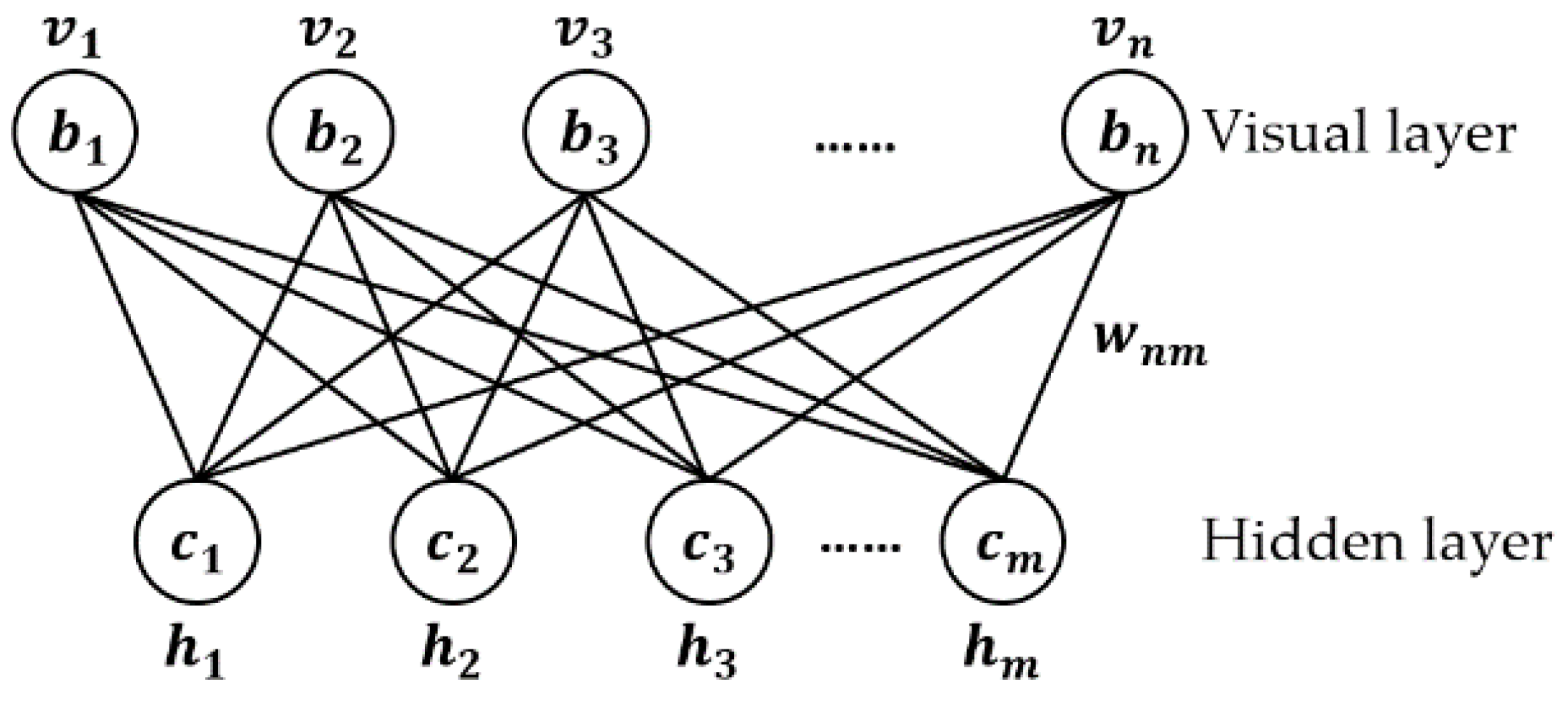
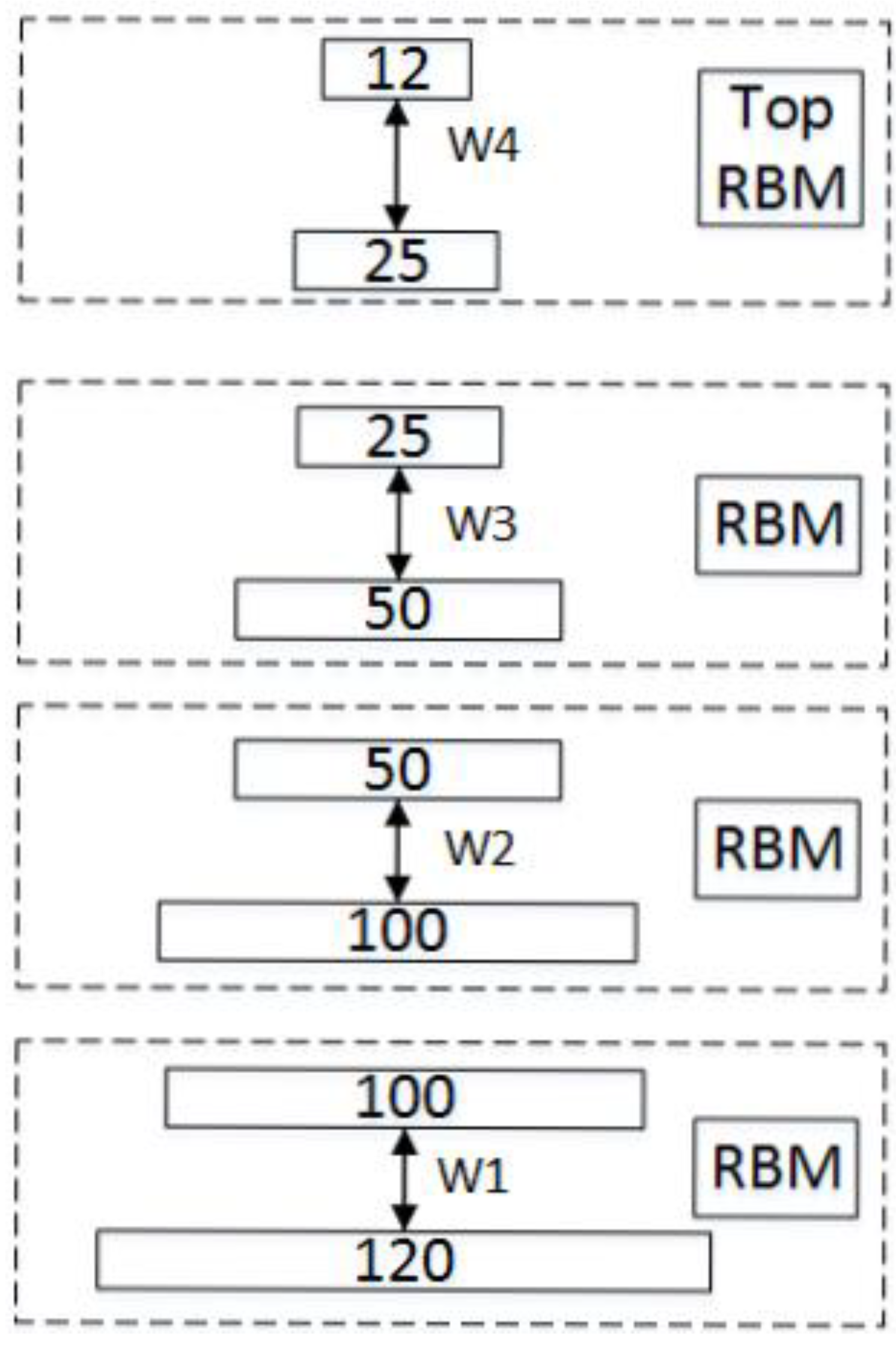

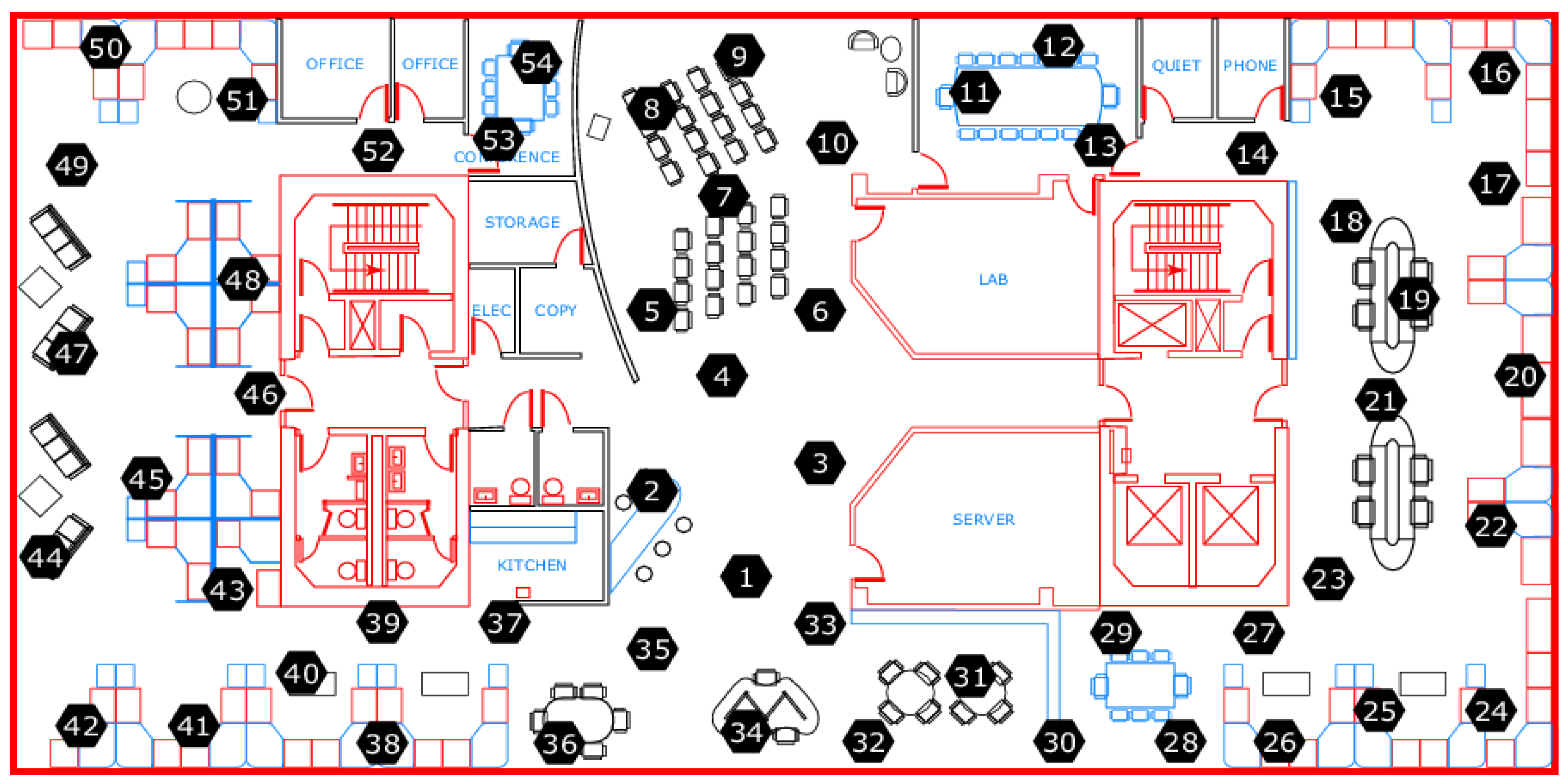
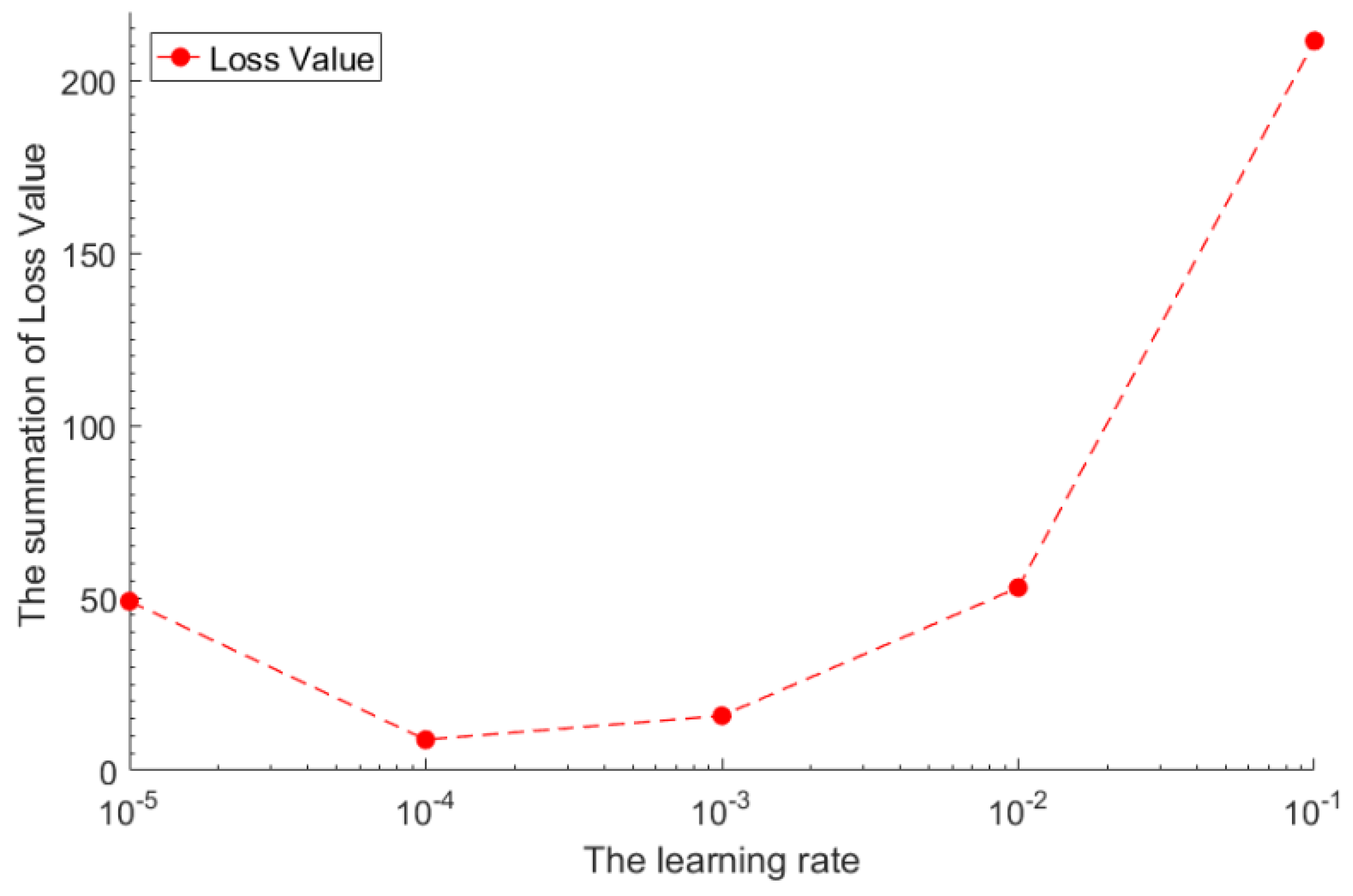
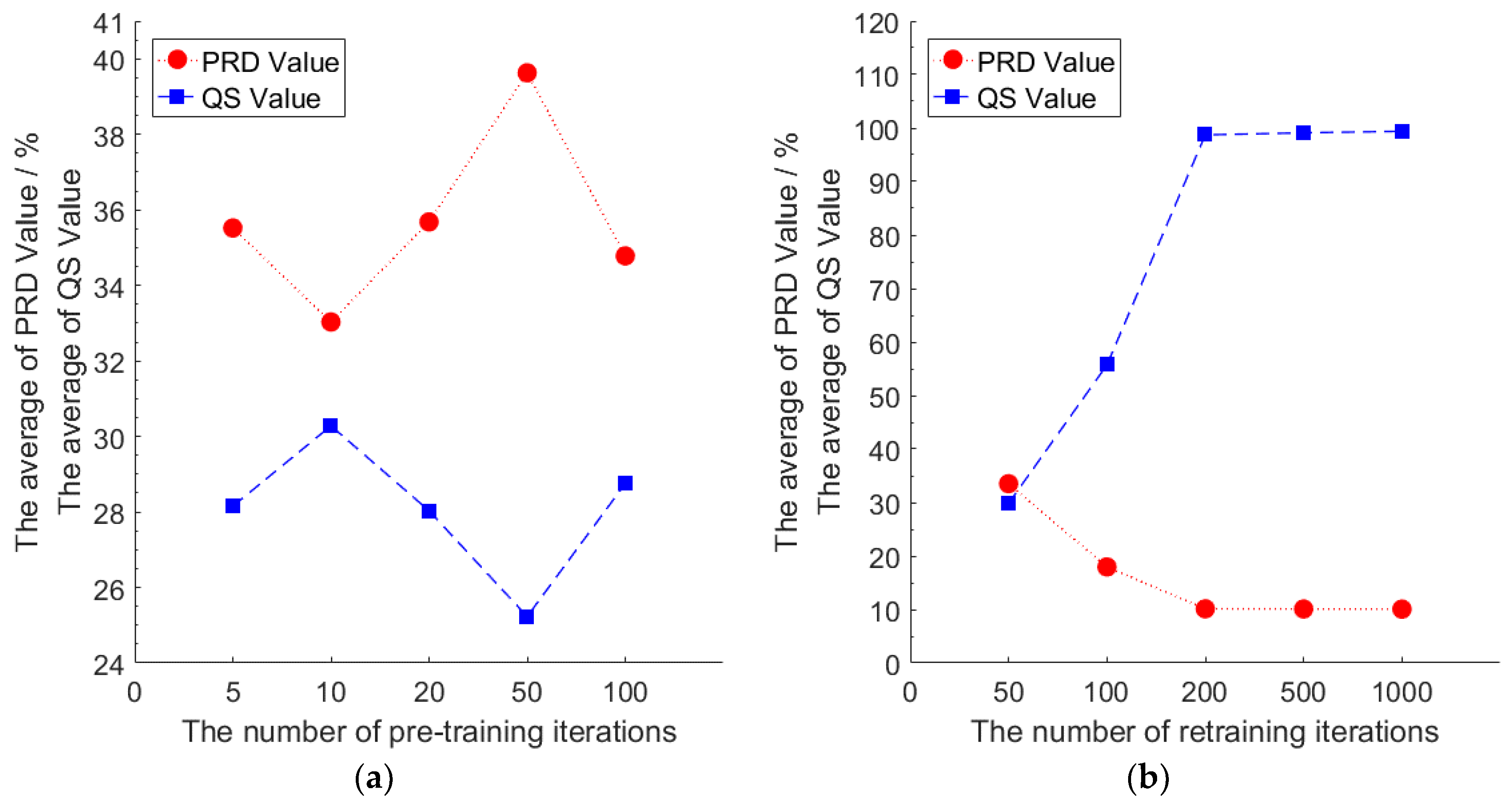
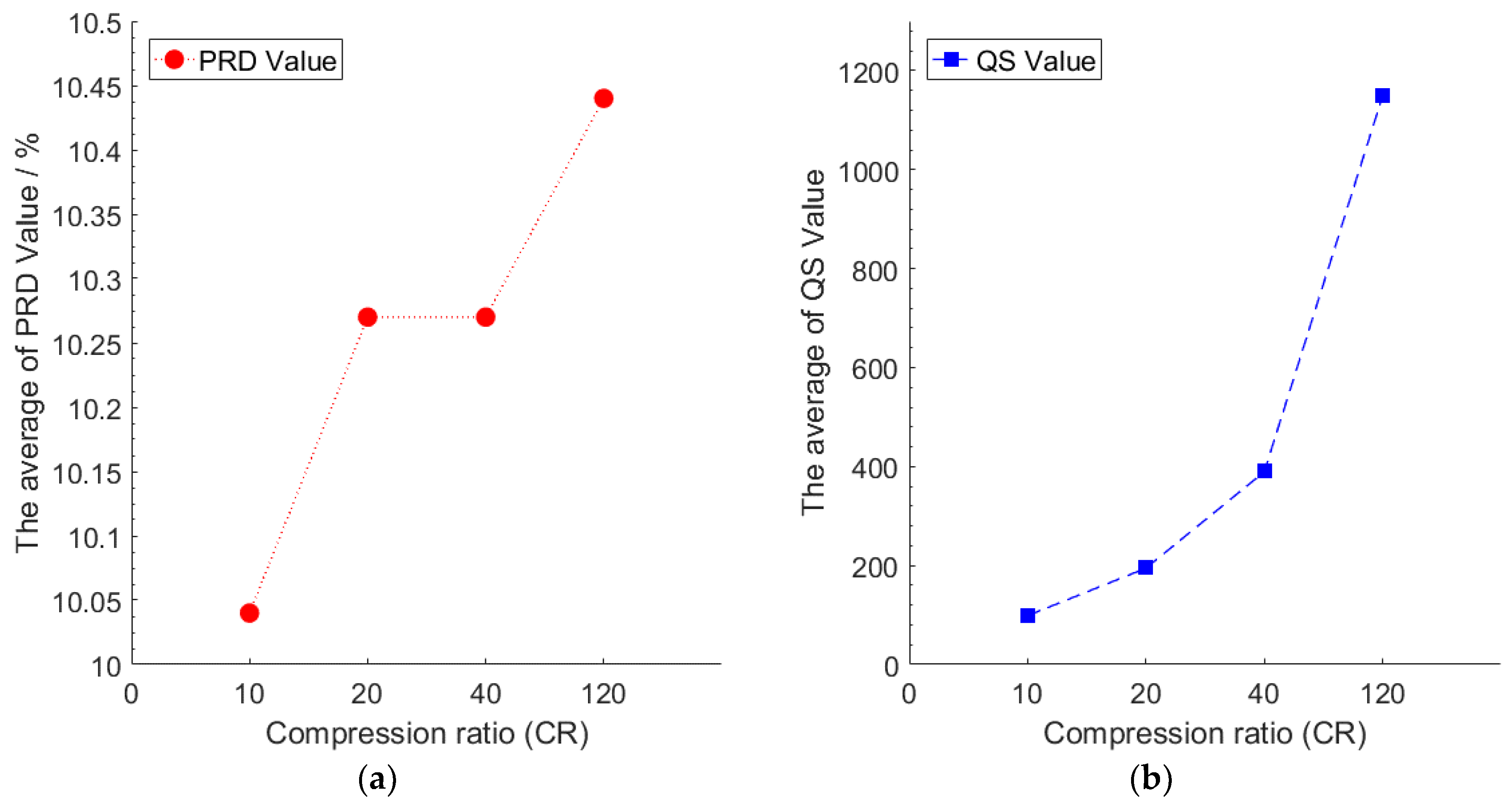






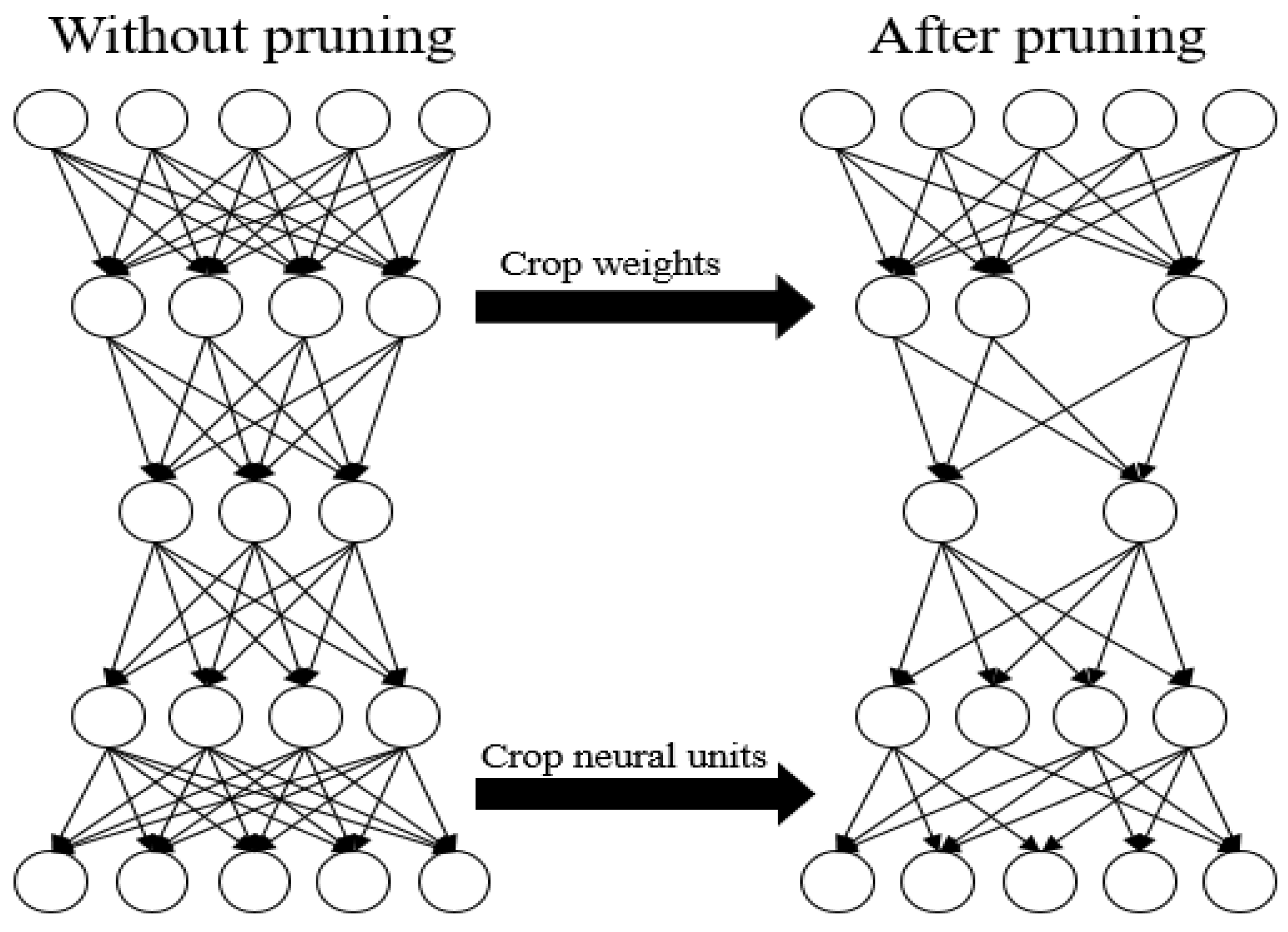
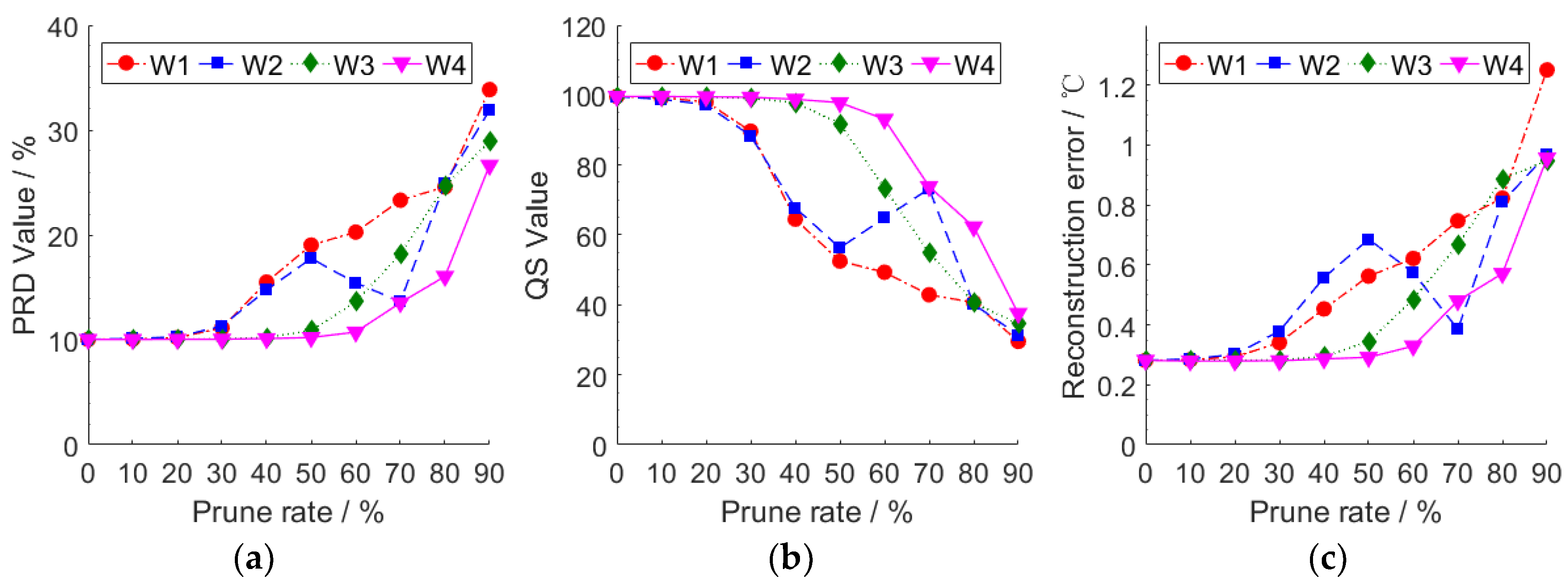
| Algorithm | PRD (%) | QS | Reconstruction Data Error (°C) |
|---|---|---|---|
| CS | 38.40 | 26.04 | 1.4143 |
| Standard RBM | 33.03 | 30.28 | 1.0423 |
| Our algorithm | 10.04 | 99.60 | 0.2815 |
| Dataset | PRD (%) | QS | Reconstruction Data Error |
|---|---|---|---|
| Argo (temperature) | 11.10 | 90.09 | 0.8434 (°C) |
| ZebraNet (location/UTM format) | 9.82 | 101.83 | 259.26 |
| CRAWDAD (speed) | 8.53 | 117.23 | 6.2056 (km/h) |
| Intel Lab (humidity) | 10.90 | 91.74 | 3.8383 (%RH) |
| Layers | Parameters Number | Storage (Byte) | Proportion (%) |
|---|---|---|---|
| 12,100 | 48,400 | 32.20 | |
| 5050 | 20,200 | 13.44 | |
| 1275 | 5100 | 3.39 | |
| 312 | 1248 | 0.83 | |
| 325 | 1300 | 0.86 | |
| 1300 | 5200 | 3.50 | |
| 5100 | 20,400 | 13.57 | |
| 12,120 | 48,480 | 32.25 |
© 2018 by the authors. Licensee MDPI, Basel, Switzerland. This article is an open access article distributed under the terms and conditions of the Creative Commons Attribution (CC BY) license (http://creativecommons.org/licenses/by/4.0/).
Share and Cite
Liu, J.; Chen, F.; Wang, D. Data Compression Based on Stacked RBM-AE Model for Wireless Sensor Networks. Sensors 2018, 18, 4273. https://doi.org/10.3390/s18124273
Liu J, Chen F, Wang D. Data Compression Based on Stacked RBM-AE Model for Wireless Sensor Networks. Sensors. 2018; 18(12):4273. https://doi.org/10.3390/s18124273
Chicago/Turabian StyleLiu, Jianlin, Fenxiong Chen, and Dianhong Wang. 2018. "Data Compression Based on Stacked RBM-AE Model for Wireless Sensor Networks" Sensors 18, no. 12: 4273. https://doi.org/10.3390/s18124273
APA StyleLiu, J., Chen, F., & Wang, D. (2018). Data Compression Based on Stacked RBM-AE Model for Wireless Sensor Networks. Sensors, 18(12), 4273. https://doi.org/10.3390/s18124273




